Jardins d'amis - Die Stadt des Hirns (Topiary Slam)
Jardins d’amis – Die Stadt des Hirns (Topiary Slam), 2017, duration: 5 ‘
Film documentation of the Joint Venture Performance in the Cabaret der Künstler, Zunfthaus Voltaire
DIE STADT DES HIRNS – TOPIARY SLAM
Joint Venture-Performance by
CAROLINE BITTERMANN with LENA SCHORNO
September 2016
Manifesta 11, Cabaret der Künstler – Zunfthaus Voltaire
Spiegelgasse 1, Zürich, Schweiz
https://www.m11.manifesta.org/en/cabaret-archive.html
The performance refers to the last issue of the dadaistic journal “Der Zeltweg” of November 1919. One of the authors was Otte Flake, besides Tristan Tzara, Walter Serner and Jean+Sophie Täuber-Arp. During a “Topiary Slam” with the wood carver Lena Schorno, we cut portraits of Otto Flake’s novel-characters and alter egos Lauda and Beust, out of two middle-seized boxtrees with a chain saw and a hedge-trimmer. As models we use a sound-collage from the Flake-novel “Die Stadt des Hirns”, announced in “Der Zeltweg”, as well as some artistic works from that same journal. Projected drawings of my series “Die Stadt des Hirns” dive the joint-venture-performance in a specific hued light-atmosphere.
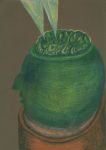
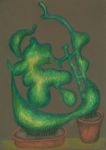
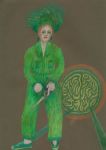
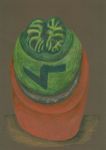
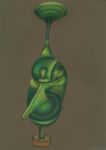
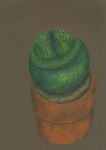
The novel’s extract cited in the performance:
DIE STADT DES HIRNS
By Otto Flake, Fischer Verlag, Berlin, 1919
… How is clarity of thought possible – what is clarity at all? …
Lauda’s first study had once been medicine, three semesters he had dissected, weighed thirty brains and always anew timidly made the exposing cut, soon into the upturned hemispheres, gelatinous seat of conscious thought, The first cut was made in the base, sharper, more structured, more architectonic part, where science moved the automatic nervous functions, which are not subject to arbitrariness, the region of the subconscious, the reflexes and the instincts that have already been deposited.
After that he had given up medicine, both because knowledge of the mechanism was not able to reveal anything about the riddle of existence, and out of aversion to experiment on the animal, to which the skull was opened, brain scraped, windowed with glass, shaken with a hammer; for science the dead brain was nothing but inert mass, it saw itself completely dependent on the living object. The inclination that lay in him to consider individual creatures as little had threatened to be transformed into such fanatical hardness that he would have closed himself off from what he was interested in, resonating in space, although his teacher had been a rare man who had not possessed the arrogance of the knife-wielders to believe that the last riddle had been solved.
Undoubtedly, the professor was more than intelligence, a piece of genius, whom colleagues forgave only in view of undeniable feat in surgery, that he encroached on their physiological field of work and developed theory of soul functions. Also artistic inclinations had made him suspicious, important musician, he built on rhythmics the relation of heart and brain, was, too sentimental for Lauda’s taste, receptive to harmony of art, hostile to disharmony, banal dualism.
Now it was strange that on the day Lauda remembered Beust, news came from their common publisher that the professor was staying in Antwerp, military medical director of a surgical military hospital. Lauda sought him out, had to smile when he saw the little man with the blunt nose of Socrates obese in uniform, which was not to his face, was greeted warmly, invited to the table. But the professor had no more time to spare, and Lauda realized that hope for discussion in questions that moved him was unrealizable. But the next day he received a package containing two books that Beust had published during the war, essays written for the educated about his research on the soul.
He quickly read them, carried them for two weeks, in the beautiful peace without acquaintance and distraction, in the finally acquired pure atmosphere of thinking existence, from apartment to office, through noisy city and quiet evening, and had a picture of how science builds up the city of the brain: not much more than an attempt, but an approximate hypothesis.
Anesthesia, daily intervention in the activity of the soul, had turned the surgeon into a psychologist. Chloroform, similar to alcohol, first accelerated by stimulation the ability of ganglia to connect, i.e. inhibition was reduced. The spark of life jumped from cell to cell more easily, until a change occurred: widening of the vascular tubes, isolation of the ganglia, paralysis, disappearance of consciousness in the blood-filled brain as a result of the isolation.
What is inhibition? Regulation of the central apparatus, avoidance of chaos of simultaneous messages, order, shutting down of all pathways in favor of the one released. The doctrine of inhibition was the basic problem of brain research. Only one thought is always free, the millions of others inhibited; concentration is elimination of all systems except for one group.
The most common explanation of inhibition was that of current and countercurrent. Current was to be defined clearly: incoming stimulation of external or internal origin in the pulsating billion system of cells, which were connected with each other by an infinite net of ganglionic filaments. But how was countercurrent to be understood, the stopping regulator? Some assumed that the incoming current not only excited one nerve pathway, but also paralyzed the others; others suspected its own function of a nervous nature, taking over the role of the telephone operator.
Evidence for both claims, contradictions, gaps in both. Beust called the hypothesis of such super-regulator smuggling of metaphysics into the mechanistic analysis, soul over soul, put up new theory, assigned the isolation of the blood fluid, which washes around the last branches of the cells through the neuroglia villi. This outrageously complicated connective tissue, in which the ganglion cells are suspended, this system of small vessels, tubules, sheathing, was for him more than supporting and nourishing tissue, for him it played at the same time the role of the silk spun around copper wires. If it narrowed, the spark jumped from cell to cell – thinking, which is crackling association, could take place; it expanded, filled with blood juice, the contact was interrupted.
He could give so good theory of sleep: Filling of the brain with blood produces elimination, face of the sleeper is reddened, that of the awakened becomes pale, observation which Lauda often made on himself. Hypnosis was also increasing concentration, dimming, isolation. Originally, the activity of neuroglia called sleeping was triggered by sunset, stimulus which was not mediated by central nerves, but by the oldest nervous system, older than spinal cord and brain, primordial nerve sympathicus. Its branches entwined the vessels from the heart to those of neuroglia, it was actual master of life; it also justified the popular opinion of the heart’s share in the life of the soul.
Thus sleep was an active function; physiologically it consisted in suspension of consciousness of place and time, of orientation, not in loss of consciousness of personality; it was periodic elimination of orientation for the environment, retraction of sensory fibers with which man is rooted in his environment. All other functions of the ego are awake, only diminished in so far as the impulse from the situational consciousness is missing – explanation of dreaming; the small electric sparks jump over even now.
The neuroglial villi existed only in the upwardly curved hemispheres, not in the tubers of the base. Here below sat above all the automatic functions, the reflexes, the mechanisms of the metabolism, the reproduction, the stimuli from definite conduction pathways like closing of the eyelids at bright light, catching of breath at cold water, those triggers, which are innate, because they have resulted in the course of the millennia as the most expedient ones and because arbitrariness in the actually vital functions would endanger existence. Into this layer sank all instincts of life assertion, which had originally once been subject to the free will, the egoistic drives in the narrow sense; slowly an order seemed to build up like rock grown from layers of stone; Beust transferred here also the instincts from milieu habit, all conservative regulatives, the philistine, so to speak, which is nothing but a tested expediency. Conversely, everything new came from the upper layer, the sphere of consciousness and free will. Here was laboratory of experiments, testing, opposition, transformation, dissolution, reshaping, progress.
Theory of inhibition led to very beautiful hypothesis about the origin of the differentiations of the primordial force. From the collision of the in itself invariable, better monistic force, which possessed only one property, the irritability, against the matter, the manifestations of the thing in itself arose. Kind of the resistances determined the kind of the manifestation, thus properties. Primordial force became perceptible by resistance of the human nerve matter, like electricity by switching on suitable resistances, light by refractive ether. Not to overlook that also the first matter was a product of the elementary force – by impact, pressure? Eternally unfathomable mystery, at whose beginning stood: the incest.
The theory that the brain and the spinal cord were further developments of the solar plexus, a beautiful name for the system of the sympathetic nervous system, was accepted without objection; Goethe recognized a rib in the skull, which arches protectively over the brain organ. Last conclusion of the construction was the creation of an apparatus, in which the power, the will, the vitality progressed to: self-consciousness, identification of the will.
But the soul was not localized in the brain; the heart, the blood, the skin, the seat of the sympathetic fibers were emphasized, cooperation was proved. Soul was every cell and cell was a solar system for itself, microcosm, because in the creation performance is not dependent on size.
One step further and one stood with Fechner, the once despised, who had ascribed the criteria of the soul to sun, earth, stone, to the inorganic. The brain consisted of some billions of little stars in a meshwork so delicate that cobwebs could be called ship ropes against it; they were hung up in it like finest little tears and sent their fire rays shining to each other; electric waves, light currents went back and forth. “City of the brain nightly phosphorescent, landscape which is universe, beyond in the brain, as infinite, as far, as indescribable as the celestial space of the astronomers,” thought Lauda, “microcosm, which now receives the stimuli from the macrocosm, rotating, racing in rotation like him; this is the cognition, which thinking must put in the center, here grasp, from here begin to form world picture.”
Whether Beust’s theory stood before science, whether it could cover the many questions it left open, was indifferent to him. It was enough to have received into a scientific thesis an idea of the difficulty and sublimity of the object around which science was striving. Sublimity: removed from every human arrogance not only by the construction of the small, which coincided with the big and the greatness, but also by the never to be solved question about the origin of force and matter.
Difficulty: as deeply as science might shine in details, as intelligently as it thought about the course of the wheels, it was denied the view of the whole gear; it was impossible for it to grasp the simultaneity of the processes only for one single minute, only for one single thought process: then it would have been no longer reconstructing, but constructing, identical with the creation.
From this it follows: whoever seeks insight does not attain it with those toys for adults which are built by the experimental psychologists, but also not through the causality links of feeling alone, otherwise the ecclesiastical man would be the insightful one, but with a feeling gained from knowledge, with a knowledge raised by feeling into the fundamental. Words, perhaps only words.
It was better to define contemplation as the intercalation of the individual consciousness in the sum of all phenomena: thus theology was avoided, which was only symbolism. It was so obvious to look for a master of work before the miraculous and gigantic of the world construction, who laid out everything existing according to a purposeful plan. But this way of looking at things inevitably led to an optimism that was not content with humility, but offered slavishly, introduced the higher intention and extracted an ethics that called what is good.
No, what is is neither good nor bad, it is. The one who inserted the absolute ethics with the absolute God, tried to adapt the phenomenon of existence to his understanding, existence was above the understanding, existence is. Who explained God, had to be able to explain, what is behind the space, that was impossible. If God was the good, then the good, in order to become perceptible, needed an inhibition, like the light, in order to become visible, needs the ether.
If this inhibition was the bad, then there were two principles, the good and the bad – inexplicable facts, unsuitable for explaining. But if this inhibition was matter, e.g. human brain, as ether is matter, so that the good became recognizable only by one of its material manifestations, then the good was a monistic concept which excluded its opposite: the good was then only good, no longer in the human sense of a property, only in the absolute, i.e. the moral interpretation. i.e. the moral interpretation of good was a nonsense, good simply coincided with primordial force, will or God: the investigation ended in an arbitrariness of words, instead of good one could have said evil just as correctly and without content. Argument about God was idle. Not to say God for primordial force had only one reason: God was a theological word, armament of the dualistic consideration which smuggled ethics into the sublime unrolling.
If the philosophizing observer played as the last trump: in view of the marvelous differentiation of the work of creation, in which step stands on step, it is permissible to think that God intends a harmony, which progresses from purification to purification – so it was to be answered: this harmony is undeniable, but it is to be understood unethically; if, to speak with Schopenhauer, the will has decided to enter into appearance, then it becomes vitality, which cannot but organize itself in such a way that life remains possible, progress is in it only in so far as it is urged, by means of its own energy, to become conscious of itself; consciousness of man is the way to identification. Matter carries in the germ feeling of itself, like body feels its warmth. Increase of consciousness is the only progress philosophy can recognize.
But what is ethics now, if it is not metaphysical absolute idea? Ethics belongs to the formed world, is norm, regulative, aid to the construction of the human community, veränderhch, historically, a question of expediency. Thinking about the best way to arrange oneself leads from the first fact, that the egoistic individual is, soon to the second one, that there are several individuals, that therefore a balance of the egoisms becomes necessary. Ethics is a field that is entirely subject to the will of man, man’s own creation, the recognition of which is free….